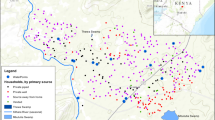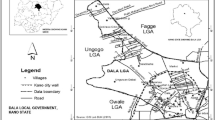Abstract
Despite the massive commitment by policy makers and stakeholders to increase the supply of water to households, many households have a deficiency in their daily quantity of water required for drinking and for general use. This paper focuses on the effect of water source and travelling time on households’ deficiency in demand for water using the GLSS6 data. A Tobit regression analysis of data on 2843 households reveals that a 1 minute increase in travelling time increases household deficiency in water demand by about 8 l (49%). Also, compared to pipe in dwelling/yard/plot, all other sources of water to the households come with greater levels of water deficiency. Government policies should focus on making more resources available to the Ghana Water Company Limited and the Community Water and Sanitation Agency so as to achieve more coverage of water accessible to both urban and rural households.
Similar content being viewed by others
References
Akpalu, W. (2012). Travel distance and household’s demand for water in Ghana. Ghana: CEERAC Working Paper No. 006, Center for Environmental Economics Research & Consultancy.
Altaf, M. A. (1994). The economics of household response to inadequate water supplies: evidence from Pakistan. Third World Planning Review (United Kingdom).
Arbués, F., Barberán, R., & Villanúa, I. (2000). Water price impact on Residential Water Demand in the city of Zaragoza. A dynamic panel data approach. In 40th European Congress of the European Regional Studies Association (ERSA) in Barcelona, Spain (pp. 30–31).
Arbués, F., Garcıa-Valiñas, M. Á., & Martınez-Espiñeira, R. (2003). Estimation of residential water demand: a state-of-the-art review. The Journal of Socio-Economics, 32(1), 81–102.
Asante, F., Berger, T., Engel, S., & Iskandarani, M. (2002). Water security in the Ghanaian Volta Basin: patterns, determinants, and consequences. Quarterly Journal of International Agriculture, 41(1), 145–167.
Basani, M., Isham, J., & Reilly, B. (2008). The determinants of water connection and water consumption: empirical evidence from a Cambodian household survey. World Development, 36(5), 953–968.
Briscoe, J., de Castro, P. F., Griffin, C., North, J., & Olsen, O. (1990). Toward equitable and sustainable rural water supplies: a contingent valuation study in Brazil. World Bank Economic Review, 4(2), 115–134.
Cameron, A. C., & Trivedi, P. K. (2005). Microeconometrics: methods and applications. Cambridge: Cambridge University Press.
Casey, J. F., Kahn, J. R., & Rivas, A. (2006). Willingness to pay for improved water service in Manaus, Amazonas, Brazil. Ecological Economics, 58(2), 365–372.
CWSA. (2014). 2014 annual report of the community water and sanitation agency. Accra: Ministry of water resources, works and housing.
Engel, S., Iskandarani, M., & del Pilar Useche, M. (2005). Improved water supply in the Ghanaian Volta Basin: who uses it and who participates in community decision-making? Washington, DC: International Food Policy Research Institute.
Ghana News Agency (2011). Ghana’s water demand expected to rise due to population growth. Modern Ghana Media Communications Limited, Accra Ghana. Retrieved from https://www.modernghana.com/news/339939/ghanas-water-demand-expected-to-rise-due-to-populationgrow.html.
Ghana Statistical Service. (2014). Ghana living standards survey. Report of the sixth round (GLSS6). Accra: Ghana Statistical Service.
Koomson, I., & Asongu, S. A. (2016). Relative contribution of child labour to household farm and non-farm income in Ghana: simulation with child’s education. African Development Review, 28(1), 104–115.
Larson, B., Minten, B., & Razafindralambo, R. (2006). Unravelling the linkages between the millennium development goals for poverty, education, access to water and household water use in developing countries: evidence from Madagascar. Journal of Development Studies, 42(1), 22–40.
Madanat, S., & Humplick, F. (1993). A model of household choice of water supply systems in developing countries. Water Resources Research, 29(5), 1353–1358.
Ministry of Health (MoH). (2001). Programme of work 2001–2006. Accra: Annual Progress Report.
Ministry of Water Resources, Works and Housing (MWRWH) (2010). Water and sanitation sector performance report.
Nauges, C., & Den Berg, V. (2009). Demand for piped and non-piped water supply services: evidence from Southwest Sri Lanka. Environmental and Resource Economics, 42(4), 535–549.
Nauges, C., & Strand, J. (2007). Estimation of non-tap water demand in Central American cities. Resource and Energy Economics, 29, 165–182.
Nketiah-Amponsah, N., Woedem, A. P., & Senadza, B. (2009). Socio-economic determinants of sources of drinking water: some insight from Ghana. Paper presented at the Conference on International Research on Food Security, Natural Resource Management and Rural Development, University of Hamburg.
Nunoo, J., & Acheampong, B. N. (2014). Protecting financial investment: agricultural insurance in Ghana. Agricultural Finance Review., 74(2), 236–247.
Persson, T. H. (2002). Household choice of drinking–water source in the Philippines. Asian Economic Journal, 16(4), 303–316.
Stoler, J., Weeks, J. R., & Otoo, R. A. (2013). Drinking water in transition: a multilevel cross-sectional analysis of sachet water consumption in Accra.
Strand, J., & Walker, I. (2005). Water markets and demand in Central American cities. Environment and Development Economics, 10(3), 313–335.
Tobin, J. (1958). Estimation of relationships for limited dependent variables. Econometrica: Journal of the Econometric Society, 26, 24–36.
UNEP (2008). Vital water graphics—an overview of the state of the world’s fresh and marine waters, 2nd edition. Nairobi, Kenya: UNEP and Arendal, Norway: GRID-Arendal. ISBN: 92–807–2236-0 http://www.grida.no/publications/vg/water2.
Wooldridge, J. (2012). Introductory econometrics: a modern approach. Boston: Cengage Learning.
World Bank Water Demand Research Team (1993). The demand for water in rural areas: determinants and policy implications. In The World Bank Research Observer, 8(1): 47–70.
Acknowledgements
The authors would rather like to acknowledge that the data for the study was made available by the Ghana Statistical Service and was given to the researchers for the basis of academic research and this is what the manuscript rightly represents.
Author information
Authors and Affiliations
Corresponding author
Ethics declarations
Conflict of Interest
The authors declare that they have no conflict of interest.
Ethical Approval
All procedures performed in this study involving human participants were in accordance with the ethical standards of the institutional and/or national research committee and with the 1964 Helsinki declaration and its later amendments or comparable ethical standards.
Informed Consent
Informed consent was obtained from all individual participants included in the study. The Ghana Statistical Service (the agency/body that collected the Ghana Living Standards Survey 6—GLSS 6) has been collecting data since 1985, been very ethical and that informed all respondents within households of their intended purposes and gave them the will to be part before collecting data from them.
Rights and permissions
About this article
Cite this article
Nunoo, J., Koomson, I. & Orkoh, E. Household Deficiency in Demand for Water: Do Water Source and Travel Time Matter?. Glob Soc Welf 5, 179–187 (2018). https://doi.org/10.1007/s40609-017-0092-6
Published:
Issue Date:
DOI: https://doi.org/10.1007/s40609-017-0092-6




